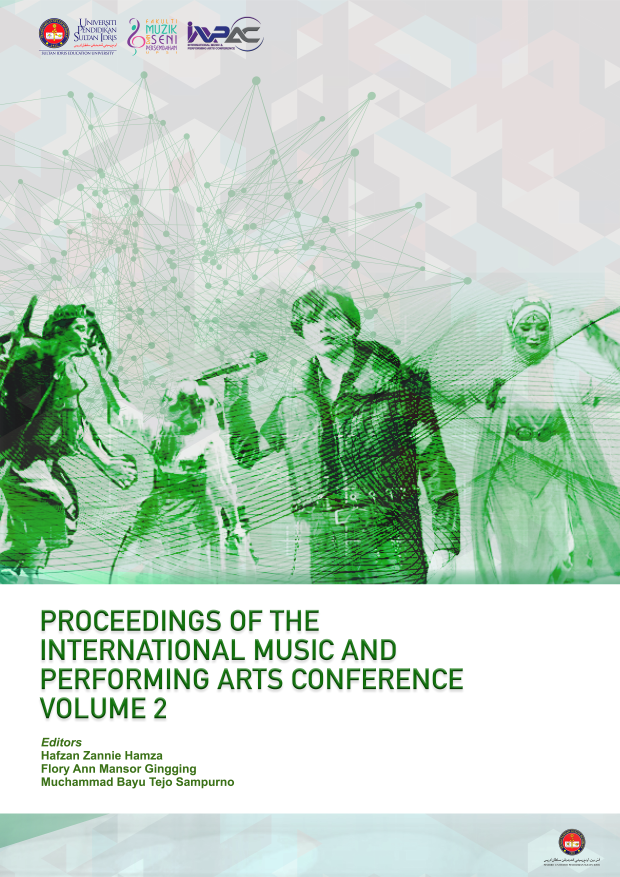Thinking of Musicians on Music Industry Landscape in Thailand
DOI:
https://doi.org/10.37134/impac.v2.7.2024Keywords:
innovative thinking, music industry in Thailand, music industry landscape, musiciansAbstract
Innovative thinking of musicians encompasses the capacity to generate novel ideas and techniques for addressing or enhancing music works across several dimensions. Musicologists have determined that innovative thinking has been present since the medieval period of Western music and continues to the present day, revolutionizing every aspect of the music landscape. Through the combination of documentary evidence and interviews in the research entitled “Desirable Characteristics of Musical Innovators in the 21st Century,” the researcher delineated the geographical focus as Thailand and identified participants as individuals with experience in music or innovation. It was found that innovative thinking influences the evolution of the music industry landscape in Thailand, categorized into four main issues: (1) Developing the manufacturing processes for mainstream music companies; (2) Creating musical genres for niche markets; (3) Developing commercial musical instruments; and (4) Formulating the curriculum of music for colleges and universities. The evolving music industry landscape necessitates that artists and associated professionals adapt to new concepts and methods. Their objective is to cultivate their talent, sustain their careers, generate innovative music concepts, etc. Consequently, innovative thinking is a crucial element driving the changing landscape of the music industry globally, including in Thailand.
Downloads
References
Amatayakul, P. (2007). Bruce Gaston, entering Thailand January 1969. Music Archives 5 Reign, Vol. 1, 518. Bangkok: Duantula.
Amatayakul, P. (2007). Grammy founding in 1983. Music Archives 5 Reign, Vol. 2, 699–700. Bangkok: Duantula.
Amatayakul, P. (2007). Origin of RS Promotions. Music Archives 5 Reign, Vol. 2, 699–700. Bangkok: Duantula.
Brilliant idea. Plastic Saxophone 'Vibrato,' the world's first Thai workmanship. (n.d.). Retrieved October 21, 2022, from https://mgronline.com/smes/detail/9510000074804
Burnett, R., & Weber, R. P. (1989). Concentration and diversity in the popular music industry, 1948–1986. Paper presented at the Annual Meeting of the American Sociological Association, August, San Francisco, CA.
Bölling, J. (2006). Das Papstzeremoniell der Renaissance: Texte-Musik-Performanz. Peter Lang GmbH.
CMC Music. (n.d.). Retrieved December 15, 2022, from http://playcmcmusic.com/about.php
Dellyana, D., & Simatupang, T. (2020). Business model innovation in the music industry: A literature review. Retrieved June 15, 2020, from https://www.researchgate.net/publication/308265800
Euajirapongpan, S., Wattanasin, P., & Janchai, A. (2020). Innovation: Definition, types, and significance for entrepreneurship. Retrieved from http://www.jba.tbs.tu.ac.th/files/Jba128/Article/JBA128_Somnuk.pdf
GMM GRAMMY. (n.d.). Retrieved December 11, 2022, from https://www.gmmgrammy.com/th/corporate.html
Kumar, V. (2015). 101 design methods: A guide to making innovation a reality in organizations (Satja Jaratrungraweeworn & Juiphng Phusumat, Trans.). IDC Premier.
Kylliäinen, J. (2020). Innovation matrix: Types of innovation—The ultimate guide with definitions and examples. Retrieved from https://www.viima.com/blog/types-of-innovation
Lin, C. Y. (2020). The evolution of Taipei’s music industry: Cluster and network dynamics in the innovation practices of the music industry. Retrieved June 16, 2020, from https://www.researchgate.net/publication/273290208
Lopes, P. D. (1992). Innovation and diversity in the popular music industry, 1969 to 1990. American Sociological Review, 57(1), 56–71. Retrieved July 20, 2020, from http://links.jstor.org/sici?sici=0003-1224
Lux, R. (2012). The book of innovators (Khomsan Khajoncheepphan-ngam, Trans.). Expernet.
O’Hara, B. (2020). Creativity, innovation, and entrepreneurship in music business education. International Journal of Music Business Research, 3(2). Retrieved July 5, 2020, from https://www.academia.edu/8667094
Partnership for 21st Century Skills. (n.d.). P21 framework definitions. Retrieved May 5, 2020, from https://files.eric.ed.gov/fulltext/ED519462.pdf
Popa, I. L., Preda, G., & Boldea, M. (2020). A theoretical approach to the concept of innovation. Retrieved from http://conference.ubbcluj.ro/mccs/RePEc/bbu/wpaper/151-156.pdf
RS GROUP. (n.d.). Retrieved December 11, 2022, from https://www.rs.co.th/th/
Sax Appeal. (n.d.). Retrieved October 21, 2022, from https://readthecloud.co/entrepreneur-vibrato-saxophone/
Sánchez, A. V., Ruiz, M. P., Olalla, A. G., Mora, P., Marín, J. A., Malla, G., ... & Eizaguirre, J. S. (2008). Competence-based learning: A proposal for the assessment of generic competences (A. Villa Sánchez & M. Poblete Ruiz, Eds.). University of Deusto.
Sutthiphong, R. (2023). Desirable characteristics of musical innovators in the 21st century [Doctoral dissertation, College of Music, Mahidol University].
Downloads
Published
Issue
Section
License
Copyright (c) 2024 Sutthiphong Ruangchante (Author)

This work is licensed under a Creative Commons Attribution-NonCommercial-NoDerivatives 4.0 International License.
Authors retain copyright and grant the Proceedings of the International Music and Performing Arts Conference (IMPAC Proceedings) the right of first publication.
This licence permits unrestricted use, distribution, and reproduction in any medium, provided the original work is properly cited.




